Iwashimizu Hachimangū|石清水八幡宮
Overview
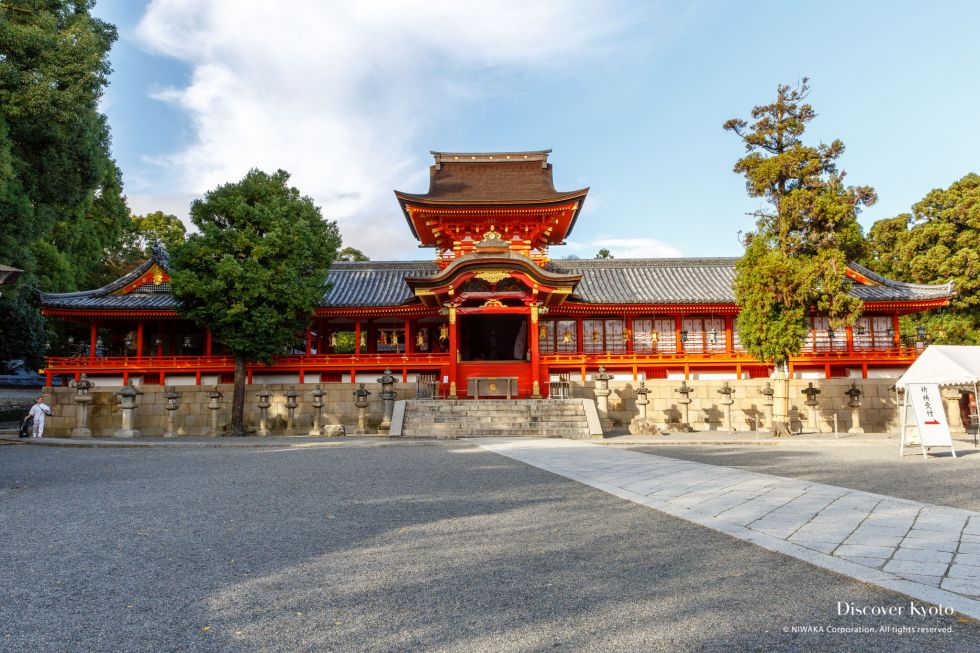
Located in the neighboring city of Yawata, Iwashimizu Hachimangū is a large shrine complex on top of Mt. Otokoyama that allows visitors to experience nature and Shinto removed from the crowds that can be encountered in Kyoto proper. With a history over a thousand years old, Iwashimizu Hachimangū is one of only four remaining examples of the Hachiman-zukuri architecture style that involves the skillful combination of different structures and their roofs that look from the outside to be wholly separate but are actually a single interior. Featuring colorful wood carvings of flora and fauna, hundreds of stone lanterns and a surprise connection to Thomas Edison, Iwashimizu Hachimangū makes for a delightful trip out of the city.
Featuring colorful wood carvings of flora and fauna, hundreds of stone lanterns and a surprise connection to Thomas Edison, Iwashimizu Hachimangū makes for a delightful trip out of the city.
Features
Otokoyama Cable Car

Since Iwashimizu Hachimangū is located on top of Mt. Otokoyama, you can either choose to take some of the winding stairs up the mountain or ride the cable car ( ¥200 one way as of November 2019). The Iwashimizu Hachimangū Sando Cable Line runs four trips up the mountain to Cable Hachimangū Sanjō Station per hour, with some changes depending on the season. Though the trip is quite short, you can enjoy a lovely view of Yawata City from the tracks, or keep your eyes forward towards the mountain itself as the funicular line climbs through tunnels and up over the trees to deposit you a few minutes short walk from Iwashimizu Hachimangū shrine and a lookout point that offers another great view of the city below.
Main Hall
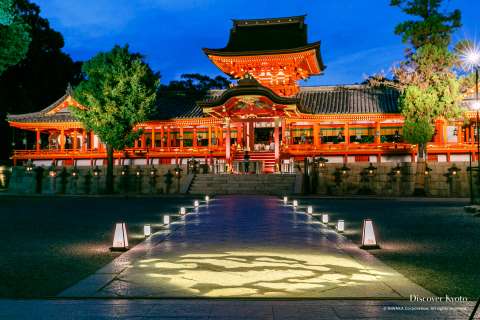
Compared to some of the shrines you can encounter in Kyoto city center, the first thing noticeable about Iwashimizu Hachimangū is its large size. With an inner hall attached to an offerings hall attached to a performance hall forming the “main hall”, surrounded by spacious corridors forming a protective square with a two-story gate in the center leading in, the shrine complex dominates the mountain skyline in brilliant vermilion. Iwashimizu Hachimangū’s main hall is particularly famous for its New Year’s décor, when giant purifying arrows are erected on either side of the hall entrance. Enshrined within Iwashimizu Hachimangū is the tutelary god of the Imperial lineage and warriors, Hachiman, in the form of a trinity composed of the deified spirits of Emperor Ōjin, the Munakata Goddesses, and Empress Jingū.
Shrine Tour
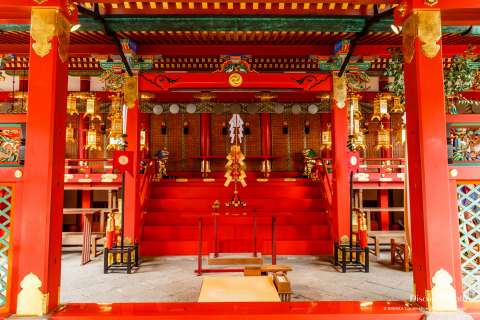
It’s rare for tourists to have the opportunity to step inside the inner sanctum of a shrine instead of just leaving an offering and prayer outside the worship hall, but at Iwashimizu Hachimangū you can join a tour in order to hear from a shrine priest about the site’s interesting history and see the fascinating architecture and art of the main hall. Two tours are held daily (with the exception of the busy January and February season) in Japanese for ¥1,000 at 11am and 2pm, lasting for approximately thirty minutes. If you need to be guided in English, please ask at the shrine office (shamusho), where one of two priests able to communicate in simple English may be available to take you. We highly recommend taking the chance to look inside and see things for yourself.
Wood Carvings
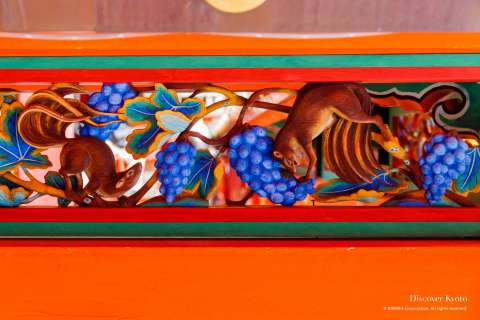
Though hidden from initial sight, Iwashimizu Hachimangū’s main hall interior features an amazingly well preserved assortment of wood carvings that were created during the Edo Period in 1634 by the famous carver Hidari Jingōro. With charming depictions of mandarin ducks amidst irises and peacocks frolicking amongst peonies, there are also quite a few carvings with interesting stories behind them.
- Nail-Eye Monkey
Hidden in the upper levels of the western corridor is a carving of a monkey that was said to have been so realistic it came to life and caused much mischief, stealing offerings to the gods and damaging the crops of villagers in the area until the deities were consulted for guidance and a bamboo nail was hammered into one of its eyes. Since then it supposedly hasn’t come back to life, and the nail can still be seen to this day.
- Rat-Faced Squirrels
Some of the animals depicted were carved based only on descriptions, with the artists never having seen one in person… resulting in some slightly odd carvings. Two squirrels carved on grape vines may look somewhat strange to observers familiar with the animal, as they are depicted with rat-faces and tentacle-like tails based on the written description of how squirrels wrap their tails around themselves and the kanji in the word “squirrel” being made of the words “chestnut” and “rat”.
- Tomoe Mishaps
A Shinto symbol often seen at Iwashimizu Hachimangū shrine is the tomoe, a circle that contains three comma shapes swirling clock-wise. However, careful inspection of the tomoe on the upper rafters in the shrine’s offering hall reveal that one is… backwards? While it might be easy to overlook or dismiss as a mistake or artistic license, this “mistake” was actually accidentally-on-purpose. Believing that if a shrine was built to perfection it could then only decline, these imperfections were intentionally added to make sure the shrine could still “go up” from there.
Lantern-Lined Path

Iwashimizu Hachimangū has over five hundred large stone lanterns on its precincts, with a large amount of them lining the sandō entrance path that leads straight from the first torii gate to the main hall. Donated by various parishioners over the centuries, these moss-topped lanterns emit a soft glow in the morning and evening, beckoning visitors to make their way to the shrine and pay their respects.
Edison Memorial
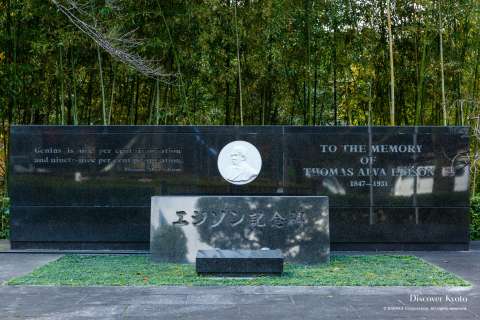
Though you may be surprised by the connection, Iwashimizu Hachimangū is the home of a small memorial to Thomas Alva Edison (1847– 1931), the prolific American inventor best known for his electric lightbulb. In order to create the filaments for his first electric lightbulb in 1880, Edison used bamboo from the shrine groves collected by his assistant, and said bamboo reportedly lasted over 1,000 hours. Festivals in his honor are held each year on the anniversaries of his birth and death.
History
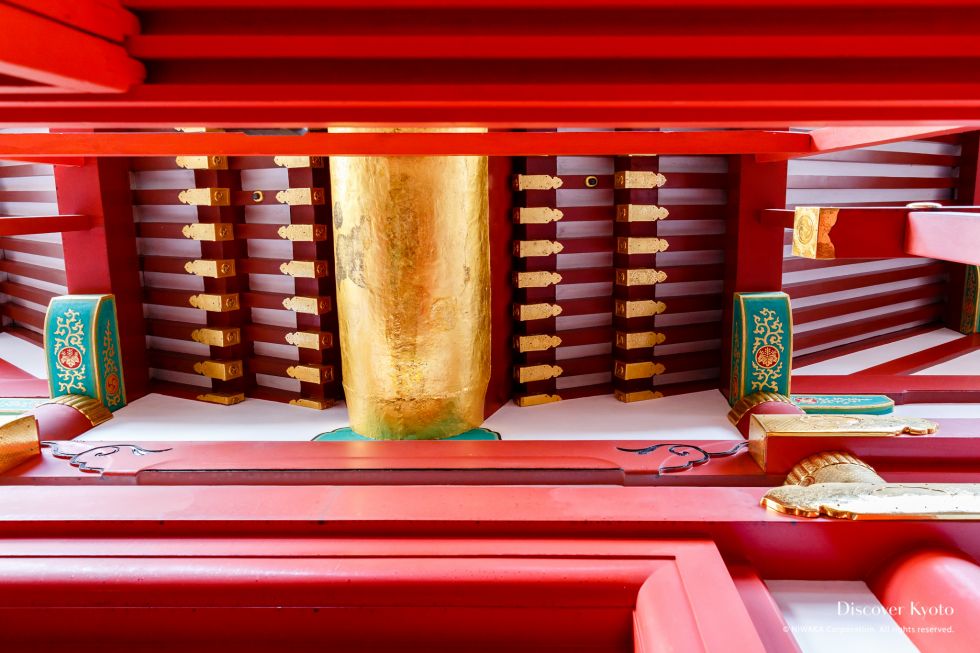
The history of Iwashimizu Hachimangū begins with an oracle, who reported to Emperor Seiwa that the god Hachiman desired to be near to Kyoto in order to protect the city and the imperial lineage. The emperor had this vision reported to the monk Gyōkyō, who reportedly then was guided by a vision of his own to select the mountain Otokoyama as the location for the shrine. Though now it is only a Shinto shrine, in the beginning Iwashimizu Hachimangū was a shrine and temple complex combining both Shinto and Buddhism called Iwashimizu Hachimangū-ji.
In the Heian Period the shrine was patroned by the Imperial family, and Emperor Murakami ordered in 965 that Iwashimizu Hachimangū be included in the list of shrines he designated should receive imperial messengers’ reports on important events and edicts.
Over time the influence of Iwashimizu Hachimangū continued to grow, and their land holdings increased exponentially until they experienced some trouble with the famous political family, the Minamoto. In those days shrines were typically exempt from tithing money for military endeavors, but when Minamoto no Yoritomo was establishing the Kamakura shogunate the shrine was pressured to contribute funds.
Over the years Iwashimizu Hachimangū was lost to lightning strike and fires seven times and rebuilt thereafter, with the current buildings dating largely to reconstruction carried out by prominent warlords of the Warring States Period and finished in 1634 by Tokugawa Iemitsu, the third Tokugawa Shogun. Modelled after the Palace of the Dragon King, the main hall is done in Hachiman-zukuri, so though looking at the roofs might suggest that the structure is two separate buildings built parallel, their interiors are actually just one hall. During this period of reconstruction Oda Nobunaga (1534 – 1582) donated gold-covered rain gutters to the shrine that can just be seen between the two rooves. Legend says that he made such an ostentatious donation because he wished to gift something that would never rot and need to be replaced, not wanting someone else’s donation to supersede his own.
It was during this Edo Period reconstruction that the famous wood carver (who may be somewhat legendary in nature) Hidari Jingōro was contracted to create art for the main hall. Known as “Hidari” (“Left”) because an injury to his right hand forced him to relearn his craft with his left, Jingōro’s work is also famous at the Tōshōgū Shrine in Nikko. Carved from single pieces of wood with no jointing or additional pieces added, his colorful works of art remain masterful examples of his craft.
Under the auspices of the State Shinto system introduced in the Meiji Period, Iwashimizu Hachimangū was ranked as a kanpei-taisha among the first rank of government supported shrines. During this period Shinto and Buddhism were forcibly separated, and the temple portions of the complex were destroyed.
Events
January 1st |
Ritual for the First Well-Water of the Year (Wakamizu Shinji) New Year’s Ritual (Saitan-sai) |
|---|---|
January 3rd | Festival of Origins (Genshi-sai) |
January 7th | Seven Herbs Porridge Festival (Nanagusa Matsuri) |
January, last weekend | Setsubun Ogre Banishing Ritual (Oni Yarai Shinji) |
February | Boiling Ritual (Yudate Shinji) |
February 11th |
National Foundation Day (Kigen-sai) Edison’s Birthday Festival (Edison Tanjō-sai) |
February | Prayer Service for Bountiful Crops (Kinen-sai) |
March 3rd | Peach Blossom Festival (Tōka-sai) |
March |
Shinto Dances by Lantern Light (Mikagura) |
March – April | Mount Otokoyama Cherry Blossom Festival (Otokoyama Sakura Matsuri) |
March |
Dedication of Folk Songs (Minyō Hōnō) Dedication of Arts to Delight the Gods (Kami Nigiwai Geinō Hōnō) |
March | Dedication of Folk Entertainment (Minzoku Geinō Hōnō) |
April | Dedication of Shakuhachi (Shakuhachi Hōnō) |
April |
Festival for Emperor Jimmu (Jinmu Tennō-sai) Prayers for Peace Among Mankind and for the Earth in Coordination with Tō-ji Temple Dedication of Bugaku (Bugaku Hōnō) |
April |
Ritual Tea Offering (Kencha Matsuri) Tea Ceremony (Chaseki Settai) |
April |
Grand Festival of Parishioners (Sūkeisha Taisai) Tea Ceremony (Chaseki Settai) |
April |
Dedication of Martial Arts Demonstrations (Budō Hōnō Enbu) Tea Ceremony (Chaseki Settai) Empress Jingu Festival (Jingū Kōgō Matsuri) Ritual Sake Offering (Kenshu-sai) |
April 29th | Showa Festival (Showa Matsuri) |
May 4th | Special Night Opening of Iwashimizu Hachimangū |
May 5th | Iris Festival (Shōbu Matsuri) |
May | Spring Ritual Tea Offering (Shunki Kencha Matsuri) |
June | Rice Planting Ritual (Otaue-sai) |
June 30th | Summer Purification Ritual (Nagoshi no Harae) |
July 7th | Tanabata Festival |
July | Yawata Taiko Drum Festival (Yawata Taiko Matsuri Miyairi) |
August 15th | Ritual to Celebrate the End of WWII (Shūsen Kinenbi Shinji) |
September 15th | Iwashimizu Festival (Iwashimizu Matsuri) |
October | Ritual Tea Offering by the Urasenke School (Urasenke Kencha Matsuri) |
October | Late Crysanthemum Festival (Zangiku Matsuri) |
October | Offering of the First Rice (Kanname-sai) |
October | Festival in Front of the Edison Memorial |
November 3rd | Meiji Festival (Meiji Matsuri) |
November | Grand Festival for Traffic Safety (Kotsū Anzen Taisai) |
November | Offering of Rice to the Emperor (Niiname-sai) |
Access
Address
〒614-8588 京都府八幡市八幡高坊30
| TEL | 075-981-3001 |
| WEB | https://iwashimizu.or.jp/ |
Admission
- General Admission: Free
Hours
- General Admission: 09:00 – 17:00
- Closed: No closing days
Transportation
Gallery
-




 +19
+19
